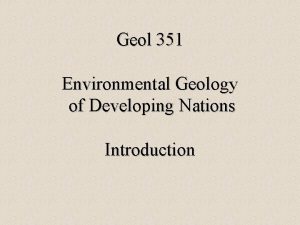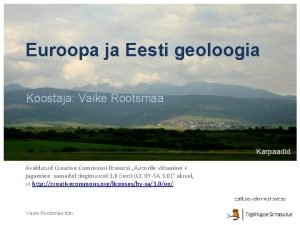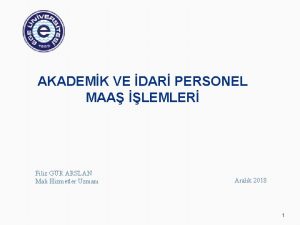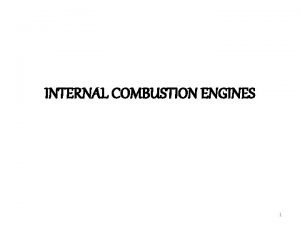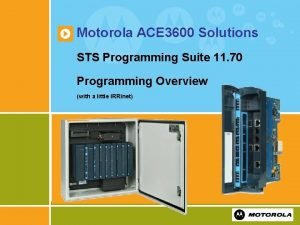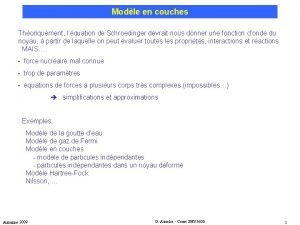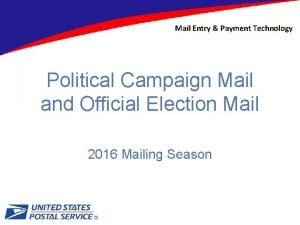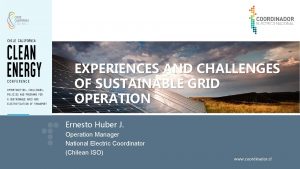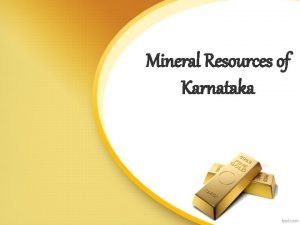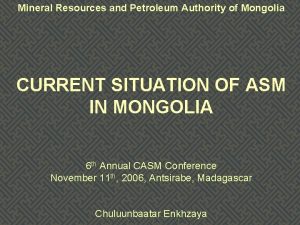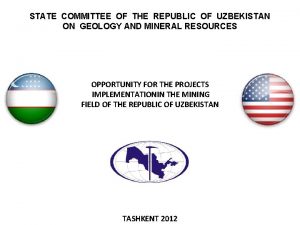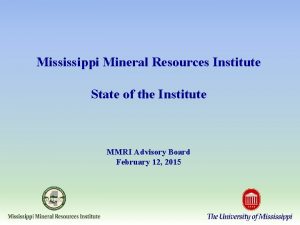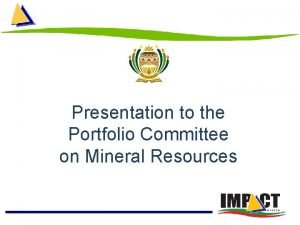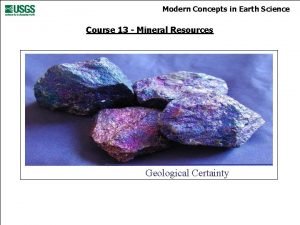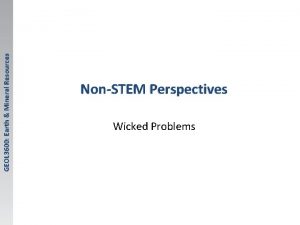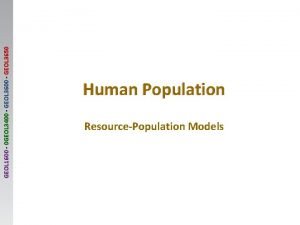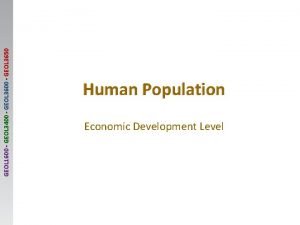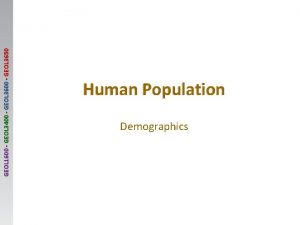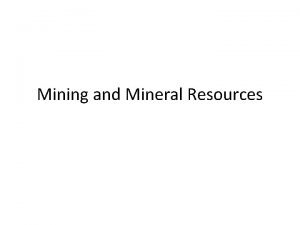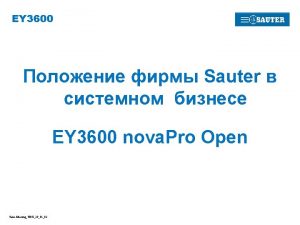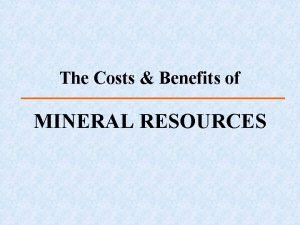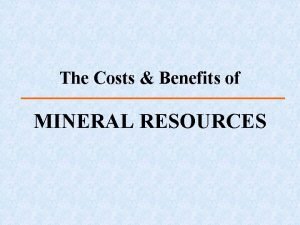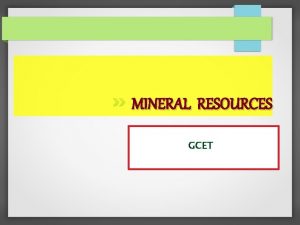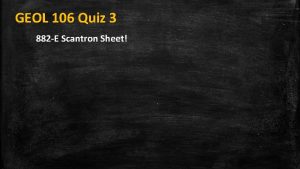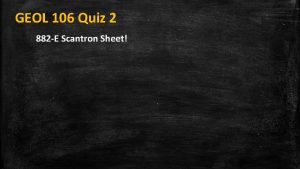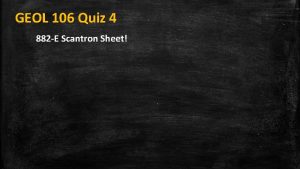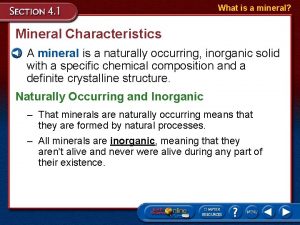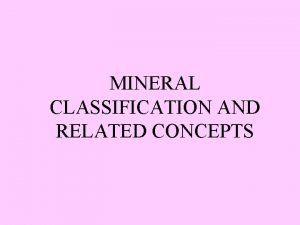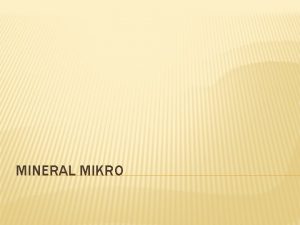GEOL 3600 Earth Mineral Resources Critical Issues Common



















- Slides: 19

GEOL 3600: Earth & Mineral Resources Critical Issues Common Pool Resources

Common Pool Resources GEOL 3600: Earth & Mineral Resources Characteristics • characteristics of a common pool resource include (Ostrom et al. 1999) – both natural and human-made resources – use of physical and/or institutional means to limit use is costly (nonexclusive) – exploitation by one user reduces resource available to other users (rivalry) – subject to free rider behavior without rules limiting access and defining rights • free rider: – overuse without concern for negative effect on others and commons – absence of contributed resources for maintaining and improving commons • solution: – limit access – create incentives encouraging good behavior 12 -Mar-21 2

Common Pool Resources GEOL 3600: Earth & Mineral Resources Resource Types 12 -Mar-21 3

Common Pool Resources GEOL 3600: Earth & Mineral Resources Tragedy of the Commons • Hardin had pessimistic view of managing commons • binary solution: – free market capitalism with someone owning commons – socialism • viewed users as: – selfish – norm-free – interested only in short-term returns • with this assumption there is only one outcome 12 -Mar-21 4

Common Pool Resources GEOL 3600: Earth & Mineral Resources Drama of the Commons • Ostrom et al. (1999) based on studying many CPR cases globally suggested actors were more diverse than Hardin’s view • possible actors: – self-centered: never co-operate (free-loaders) [Hardin] – cautious: only cooperate if assured won’t be exploited by free-loaders – good guys: co-operate as means of building trust with assumption others will return the trust – altruists: co-operate to ensure higher returns for entire group • if this true, binary outcome is not only possibility • for small-scale, locally governed commons both success and failure stories 12 -Mar-21 5

Common Pool Resources GEOL 3600: Earth & Mineral Resources Commons Scales • Araral (2014) suggested discussions of commons must necessarily consider scale – local: small spatial footprint intersect limited number political and social units, e. g. small watershed – large-scale: spans several intranational units, i. e. states, provinces, e. g. Chesapeake Bay – national: within a single country, e. g. Yellow River in China, Congo River in DRC – regional: spans several countries, e. g. Colorado, Mekong, Nile, and Ganges Rivers – global: outside jurisdiction of any one or group of countries • governance mechanisms: – compacts – treaties 12 -Mar-21 6

Common Pool Resources GEOL 3600: Earth & Mineral Resources Global Commons: Characteristics • characteristics (Ostrom et al. , 1999) – resource difficult to quantify, i. e. measure, accurately – quantification requires advanced technologies – marked by extreme size – large degree of uncertainty • bigger than village, large watershed, or single nation where there are examples of successful CPR management 12 -Mar-21 7

Common Pool Resources GEOL 3600: Earth & Mineral Resources Global Commons: Governance Difficulties • problems of using local CPR governance mechanisms (Ostrom et al. , 1999) – scale-up: larger number of stakeholders, makes rule defining and enforcing difficult – cultural diversity: decreases likelihood of shared interests and understandings – interconnections: global CPRs are linked, e. g. atmosphere and oceans, climate change and biodiversity – accelerating rate of change: means learning by doing isn’t too effective, things change so fast have a new system state that is not appropriate for what was learned – unanimous agreement: governance is international treaty, all must agree – no room for error: in past when commons was destroyed, moved to another area, option not available 12 -Mar-21 8

Common Pool Resources GEOL 3600: Earth & Mineral Resources factors • commons: – level of excludability & rivalry, renewability, mobility, stationarity, boundary definition • users: – group size, cultural homogeneity, social capital or density of social networks, level of reciprocity, alternative resources available 12 -Mar-21 9

Common Pool Resources GEOL 3600: Earth & Mineral Resources How does CPR concept tie into resource use? • What is the connection between CPRs and Earth and mineral resource exploitation? – impacts CPRs • At what scales? – all • What does this mean? – to win social approval, producers must deal with a wide range of stakeholders with potentially very different views 12 -Mar-21 10

Common Pool Resources GEOL 3600: Earth & Mineral Resources Small scale: Pebble Mine, Bristol Bay, Alaska • copper-gold-molybdenum deposit – discovered in 1988 but of low grade – Pebble West (Kean, 2010) – 2005, drilling revealed richer Pebble East • 3 km x 4 km • estimated 10. 78 billion tons of ore – 8 th largest copper deposit • metals – 80 billion pounds copper – 107 million ounces gold – 5 billion pounds molybdenum • metal/ore: 10. 6 lbs/ton EPA (2015) 12 -Mar-21 11

Common Pool Resources GEOL 3600: Earth & Mineral Resources Small scale: Pebble Mine, Bristol Bay, Alaska EPA (2015) 12 -Mar-21 12

Common Pool Resources GEOL 3600: Earth & Mineral Resources Small scale: Pebble Mine, Bristol Bay, Alaska • operations from preliminary documents, not finalized • open-pit (Snyder, 2014): – 0. 5 mi deep, 6 mi 2 – tailings ponds (3): 18 mi 2 – dam: 3 mi x 740 ft high • massive water requirement – initial permits for 76 x 106 l/d – concerns about returned water temperature, salinity, turbidity (Kean, 2010) • support: – 160 km service road to Pacific Port – own power supply – accommodations for ~1, 000 workers for 80 years EPA (2015) 12 -Mar-21 13

Common Pool Resources Small scale: Pebble Mine, Bristol Bay, Alaska GEOL 3600: Earth & Mineral Resources Morenci Mine, AZ 12 -Mar-21 14

Common Pool Resources GEOL 3600: Earth & Mineral Resources Small scale: Pebble Mine, Bristol Bay, Alaska • Bristol Bay watershed: 40, 000 mi 2 • world’s largest sockeye salmon run – average 37. 5/yr, max of 60 million – 46% world’s sockeye abundance – 50% global commercial sockeye catch – 40% Alaska’s commercial sockeye catch • supports 14, 000 direct jobs and $1. 5 billion industry 12 -Mar-21 15

Common Pool Resources GEOL 3600: Earth & Mineral Resources Small scale: Pebble Mine, Bristol Bay, Alaska 12 -Mar-21 16

Common Pool Resources GEOL 3600: Earth & Mineral Resources Regional scale: Grand Ethiopian Renaissance Dam 12 -Mar-21 17

GEOL 3600: Earth & Mineral Resources Common Pool Resources • Hardin, G. (1968). The Tragedy of the Commons. Science, 162(3859), 1243 -1248 • Ostrom, E. , Burger, J. , Field, C. B. , Norgaard, R. B. , & Policansky, D. (1999). Revisiting the Commons: Local Lessons, Global Challenges. Science, 284(5412), 278 -282. • Mansbridge, J. (2014). The role of the state in governing the commons. Environmental Science & Policy, 36(0), 8 -10. doi: http: //dx. doi. org/10. 1016/j. envsci. 2013. 07. 006 • Araral, E. (2014). Ostrom, Hardin and the commons: A critical appreciation and a revisionist view. Environmental Science & Policy, 36(0), 11 -23. doi: DOI 10. 1016/j. envsci. 2013. 07. 011 • Ostrom, E. (2008). The Challenge of Common-Pool Resources. Environment: Science and Policy for Sustainable Development, 50(4), 8 -21. doi: 10. 3200/ENVT. 50. 4. 8 -21 • Stern, P. C. (2011). Design principles for global commons: Natural resources and emerging technologies. International Journal of the Commons, 5(2), 213– 232 • Dietz, T. , Ostrom, E. , & Stern, P. C. (2003). The Struggle to Govern the Commons. Science, 302(5652), 19071912. doi: 10. 1126/science. 1091015 12 -Mar-21 18

GEOL 3600: Earth & Mineral Resources Summary 12 -Mar-21 19
 Geol 351
Geol 351 Settelünk geoloogias
Settelünk geoloogias Critical semi critical and non critical instruments
Critical semi critical and non critical instruments Principle of sterilization
Principle of sterilization 4225-3600
4225-3600 Ace 3600
Ace 3600 657 derece kademe tablosu
657 derece kademe tablosu Mechanical efficiency of engine
Mechanical efficiency of engine Irrinet m manual
Irrinet m manual 3600/23
3600/23 Echo bearcat generator 3600
Echo bearcat generator 3600 Campaign mail technology
Campaign mail technology 110000/3600
110000/3600 Mineral resources of karnataka
Mineral resources of karnataka Mineral resources and petroleum authority of mongolia
Mineral resources and petroleum authority of mongolia Strip mining before and after
Strip mining before and after Aieser gava
Aieser gava Mississippi mineral resources institute
Mississippi mineral resources institute Portfolio committee on mineral resources and energy
Portfolio committee on mineral resources and energy Placers
Placers
